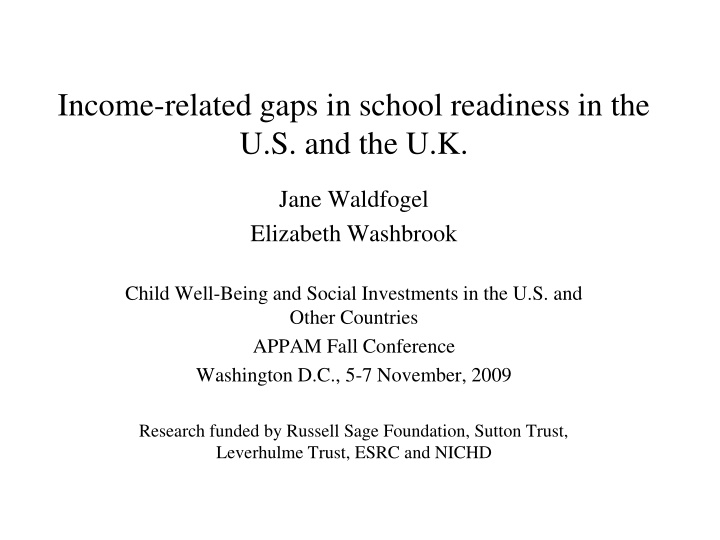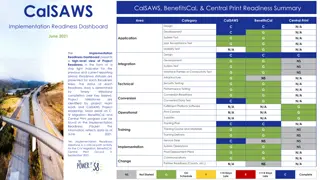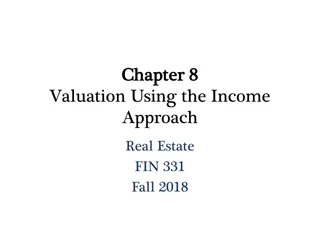Income-Related Disparities in School Readiness: A Comparative Study of the U.S. and the U.K.
Documenting income-related gaps in school readiness between children born into different income quintiles in the U.S. and the U.K., this research explores cognitive and behavioral outcomes and examines how demographic characteristics and policy-relevant mechanisms may influence these disparities. The study uses nationally representative birth cohort data from the early 21st century to analyze the impact of income on school readiness, highlighting potential areas for policy interventions.
Download Presentation

Please find below an Image/Link to download the presentation.
The content on the website is provided AS IS for your information and personal use only. It may not be sold, licensed, or shared on other websites without obtaining consent from the author.If you encounter any issues during the download, it is possible that the publisher has removed the file from their server.
You are allowed to download the files provided on this website for personal or commercial use, subject to the condition that they are used lawfully. All files are the property of their respective owners.
The content on the website is provided AS IS for your information and personal use only. It may not be sold, licensed, or shared on other websites without obtaining consent from the author.
E N D
Presentation Transcript
Income-related gaps in school readiness in the U.S. and the U.K. Jane Waldfogel Elizabeth Washbrook Child Well-Being and Social Investments in the U.S. and Other Countries APPAM Fall Conference Washington D.C., 5-7 November, 2009 Research funded by Russell Sage Foundation, Sutton Trust, Leverhulme Trust, ESRC and NICHD
Motivation A growing inter-disciplinary literature suggest the early years are a critical period in the development of human capabilities Socio-economic differences in school readiness may cast a long shadow The returns to policy interventions in the early years may be greater than at later ages The U.S. and the U.K. are both characterized by high income inequality and low intergenerational mobility, but have very different public policy environments around young families (e.g. paid maternity leave, universal child benefit, universal free nursery places for 3- and 4-year olds)
Aims Document the gaps in indicators of school readiness between children born into different income quintile groups at the start of the 21stcentury, contrasting United States and United Kingdom Cognitive and behavioral outcomes Explore how far the gaps can be explained by conditioning on A sparse set of comparable demographic characteristics - race/ ethnicity, maternal education, age, family structure and size A rich set of policy-relevant mechanisms parenting behaviors, neighborhood and material circumstances, family health and well-being, pre-school care arrangements
Some caveats No assumption that income causes differences in parenting behavior and lifestyle factors Our interest is in the areas in which policy interventions may potentially be effective in closing the income-related gaps regardless of whether they are caused by income or something else Many other factors differ across the two countries besides policy we cannot know the counterfactual (at least in a cross-sectional study)
Data Two nationally representative birth cohort studies of children born at the start of the 21stcentury US: ECLS-B data on 10,000 children born in 2001 UK: MCS data on 19,000 children born in 2000/1 Sample selection criteria Biological mother main respondent at all 3 waves 9 months, 2 (3) years and 4 (5) years in the US (UK) Valid scores for all cognitive and behavioral assessments Working samples 7250 (US) and 8864 (UK) Income quintile groups Defined [using survey weights] according to gross, real, equivalized household income averaged over the three waves.
Outcome scores Four composite indices constructed from multiple scales using principal components analysis. Normed to mean zero, standard deviation one. US Cognitive. 6 sub-scales (all age 4). Receptive vocabulary; Expressive language; Mathematics; Literacy; Color knowledge; Copying ability UK Cognitive. 5 sub-scales. Bracken School Readiness Assessment (age 3); British Ability Scales Naming Vocabulary (ages 3 and 5); Pattern Construction (age 5) and Picture Similarities (age 5) US Behavior. 21 mother-report items (all age 4). Most taken from the PKBS-2. UK Behavior. 25 mother-report items (all age 5). From the SDQ scales on hyperactivity/inattention; conduct problems; emotional symptoms; peer problems; pro-social behavior
Figure 1. Mean gross equivalized annual household income, by income quintile group 80 USA UK 70 60 Thousands US dollars Reference group 50 40 30 20 10 0 Q1 Q2 Q3 Q4 Q5 Q1 Q2 Q3 Q4 Q5 Income quintile group 95% CI
Figure 2. Cognitive outcome gaps, with no additional controls = IncQ 1 + + + + ' + Outcome IncQ IncQ IncQ X 1 2 2 4 4 5 5 i i i Q1 coef Q2 coef Q4 coef Q5 coef 1.00 0.80 0.60 Standard deviations 0.40 0.20 0.00 . -0.20 -0.40 -0.60 -0.80 US UK -1.00
Figure 3. Behavior outcome gaps, with no additional controls = IncQ 1 + + + + ' + Outcome IncQ IncQ IncQ X 1 2 2 4 4 5 5 i i i Q1 coef Q2 coef Q4 coef Q5 coef 1.00 0.80 0.60 Standard deviations 0.40 0.20 0.00 . -0.20 -0.40 -0.60 -0.80 US UK -1.00
Figure 4. Cognitive outcome gaps, with additional sets of controls = IncQ 1 + + + + ' + Outcome IncQ IncQ IncQ X 1 2 2 4 4 5 5 i i i Q1 coef Q2 coef Q4 coef Q5 coef No controls Demographic controls 1.00 All controls 0.80 0.60 Standard deviations 0.40 0.20 0.00 . -0.20 -0.40 -0.60 -0.80 US UK US UK US UK -1.00
Figure 5. Behavior outcome gaps, with additional sets of controls = IncQ 1 + + + + ' + Outcome IncQ IncQ IncQ X 1 2 2 4 4 5 5 i i i Q1 coef Q2 coef Q4 coef Q5 coef No controls Demographic controls 1.00 All controls 0.80 0.60 Standard deviations 0.40 0.20 0.00 . -0.20 -0.40 -0.60 -0.80 US UK US UK US UK -1.00
Figure 6. Breakdown of the US cognitive gaps USA Income coeffcient Maternal education # Children Nationality & ethnicity Family structure Mother's age Parenting Neighborhood & mat circs Family health and well-being Care arrangements -0.4 -0.3 -0.2 -0.1 0.0 0.1 0.2 0.3 0.4 0.5 Standard deviations Low income penalty High income advantage
Figure 7. Breakdown of the UK cognitive gaps UK Income coeffcient Maternal education # Children Nationality & ethnicity Family structure Mother's age Parenting Neighborhood & mat circs Family health and well-being Care arrangements -0.4 -0.3 -0.2 -0.1 0.0 0.1 0.2 0.3 0.4 0.5 Standard deviations Low income penalty High income advantage
Figure 8. Breakdown of the US behavior gaps USA Income coeffcient Maternal education # Children Nationality & ethnicity Family structure Mother's age Parenting Neighborhood & mat circs Family health and well-being Care arrangements -0.3 -0.2 -0.1 0.0 0.1 0.2 0.3 Standard deviations Low income penalty High income advantage
Figure 9. Breakdown of the UK behavior gaps UK Income coeffcient Maternal education # Children Nationality & ethnicity Family structure Mother's age Parenting Neighborhood & mat circs Family health and well-being Care arrangements -0.3 -0.2 -0.1 0.0 0.1 0.2 0.3 Standard deviations Low income penalty High income advantage
Conclusions I Income-related gaps in school-readiness are broadly similar in the US and the UK Large gaps in cognitive outcomes (more than a standard deviation gap between richest and poorest quintiles) Smaller gaps in behavioral outcomes Almost entirely explained by observable factors with some second-order differences The U.S. shows greater inequality in cognitive outcomes at the top of the income distribution But less inequality in behavior outcomes at the bottom of the income distribution
Conclusions II Material circumstances matter more for cognitive development, family health and well-being for behavioral development Parenting behavior matters a lot for both. But can it be changed by policy? There is evidence that it can (e.g. NFP), in which case policy may have a double pay-off But parenting programs are potentially expensive, politically difficult and have uncertain returns
Conclusions III Differences in preschool care arrangements do not explain the outcome gaps between low- and higher- income children in either country. We do not measure quality or consistency of arrangements Programs are already targeted (Head Start and Sure Start) We assume the effects of child care are the same for all Early education programs may still be the most effective policy mechanism to compensate for income-related differences in parenting and the home environment
Next steps We aim to contrast these findings with those from two high inequality, highintergenerational mobility countries Canada and Australia (with Miles Corak and Bruce Bradbury) Does Canadian and Australian success in promoting equality of life chances begin in the early years? Or does it come later in school or the labor market? How does the picture change if we compare children across countries with the same amounts of money income (rather than relative position)?























